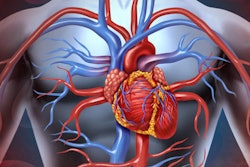Quantitative stress echocardiography with contrast-based myocardial blood flow (MBF) measurements can successfully detect coronary artery disease, according to research published online in Heart.
"By the comparison with the angiographic gold standard in humans, the present study demonstrates that quantitative stress testing based on myocardial blood flow measurements obtained from contrast echocardiography is feasible and accurately identifies significant coronary artery disease," wrote a research team led by Dr. Rolf Vogel, Ph.D., and Dr. Andreas Indermühle of Bern University Hospital in Switzerland.
Seeking to determine the diagnostic reliability of myocardial blood flow measurements and compare the approach with established myocardial contrast echocardiography (MCE), the Swiss researchers prospectively studied 48 patients who were eligible for pharmacologic stress testing by MCE and were also willing to undergo subsequent coronary angiography (Heart, August 12, 2008).
Exclusion criteria included acute coronary syndrome, history of myocardial infarction, coronary artery bypass graft surgery, congestive heart failure, higher-degree atrioventricular block, sick sinus syndrome, atrial fibrillation with uncontrolled ventricular rate, severe valve or pulmonary disease, and known allergy to adenosine or the SonoVue ultrasound contrast agent (Bracco, Milan, Italy).
After infusion of SonoVue, real-time contrast echo was performed using a Sequoia C512 ultrasound scanner (Siemens Healthcare, Malvern, PA). Subsequently, patients received biplane coronary angiography followed by left ventricular angiography performed via the right femoral approach.
The researchers then analyzed baseline and adenosine-induced hyperemic myocardial blood flow according to a three-coronary-artery-territory model. Vascular territories were categorized into three groups with increasing stenosis severity defined as percent diameter reduction by quantitative coronary angiography, according to the study team.
Myocardial blood flow reserve (MBFR) -- the ratio of hyperemic to baseline MBF -- was obtained in 128 (89%) territories, according to the researchers. Mean baseline myocardial blood flow was 1.073 ± 0.395 mL/min-1/g-1 and did not differ between territories supplied by coronary arteries with mild (< 50% stenosis), moderate (50% to 74% stenosis), or severe (≥ 75% stenosis) disease.
In other findings, the researchers found that mean hyperemic MBF and MBFR were 2.509 ± 1.078 mL/min-1·g-1 and 2.54 ± 1.03, respectively, and decreased linearly (r2 = 0.21 and r2 = 0.39) with stenosis severity. From receiver operating characteristic (ROC) analysis, the authors determined that a territorial MBFR less than 1.94 detected 50% or greater stenosis with 89% sensitivity and 92% specificity.
"The present study demonstrates that quantitative MCE is feasible with a low number of failures," the authors wrote. "Excluding two patients, where stress testing failed due to [SonoVue] infusion pump malfunction and adenosine intolerance, complete MCE data were obtained in 93% of the territories."
By Erik L. Ridley
AuntMinnie.com staff writer
August 18, 2008
Related Reading
U.S. echo contrast agent use dips in Q2, August 14, 2008
FDA formally updates echo contrast black box warning, July 18, 2008
FDA ultrasound contrast safety meeting sparks discussion, hope for the future, July 10, 2008
Stress echo contrast studies reveal solid safety record, July 9, 2008
More study of heart imaging agent risks urged, June 25, 2008
Copyright © 2008 AuntMinnie.com


















